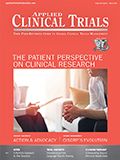FDA Clarifies Research Policies on Cell and Gene Therapies
Applied Clinical Trials
FDA officials provide more specific plans for streamlining and modernizing plans for assessing and regulating products for cutting-edge cellular and gene-based medical treatments.
A surge in R&D for cutting-edge cellular and gene-based medical treatments is prompting FDA officials to spell
Jill Wechsler

out more specifically its plans for streamlining and modernizing plans for assessing and regulating these products. Main initiatives involve expanding the agency’s cadre of experts tasked with evaluating innovative cell and gene therapies and clarifying clinical research policies and strategies for this area.
FDA anticipates that sponsors and researchers will file more than 200 investigational new drug applications (INDs) for these products by 2020, adding to the more than 800 applications currently on file for cell-based or directly administered gene therapy applications. That pipeline will lead to the approval of 10 to 20 new drugs in this area by 2025.
Academics and research organizations are similarly enthusiastic. The MIT Focus Project, which seeks to devise new coverage and payment methods for innovative, but costly, cell and gene therapies, predicts the approval by 2030 of 40-60 important curative products in this field; these will treat about 50,000 patients and cost more than $200 billion a year.
These advances reflect a “turning point” in the development of these technologies and their application to human health, observed FDA Commissioner Scott Gottlieb and Peter Marks, director of the Center for Biologics Evaluation and Research (CBER), in a statement issued in January. They provide an update for the biomedical research community on agency initiatives in this area, noting similarities to the accelerated growth of antibody drugs in the late 1990s. Recent advances, they observe, have been spurred by the development of safe and effective vectors for delivering gene therapies to patients.
More expertise, advice
To continue these gains, FDA plans to add 50 reviewers to expand the expert staff in CBER and other relevant offices. The aim is to bolster the group charged with overseeing the clinical investigation, development, and review of these products. A main challenge is to recruit high-level scientists and medical officers, a continual difficulty for the agency.
Meanwhile, more FDA guidance documents aim to clarify policies and further advance innovation in this area. A recent advisory outlines how sponsors may use expedited programs to advance regenerative medicines, including the regenerative medicine advanced therapy (RMAT) designation and accelerated approval options, to facilitate the development of cellular and gene therapy products that offer meaningful improvements over available treatments for serious or life-threatening conditions. And to encourage the development of treatments in certain promising medical areas, the agency will publish guidance on developing gene therapies that target neurodegenerative disorders. Further advice will address inherited blood conditions such as hemophilia, where oversight and study requirements may vary depending on the effect of a gene therapy on a disease target. With accelerated approval approaches, FDA also will require post market follow-up studies to assess risks and possible side effects that cannot be determined prior to approval.
Minimizing study requirements
At the same time, the agency will seek to assist small firms and academic investigators that may be skirting FDA regulation for fear of being required to run costly clinical studies and to meet complex research requirements. Here, FDA plans to outline innovative trial designs that permit researchers to pool clinical data for products utilizing a common manufacturing protocol and product quality specifications.
This initiative reflects the agency’s interest in encouraging industry to adopt more modern and reliable ways to manufacture these innovative products by reassuring sponsors that additional clinical trials may not be necessary to support all changes in production processes. Guidance here will explain that in certain situations, limited bridging studies and additional real-world data may be sufficient following production changes that implement advanced technologies. At the same time, bridging studies may be needed when more than minor changes are made in manufacturing processes, a topic that will be discussed by agency and research experts at a public meeting.
While emphasizing flexibility in dealing with these innovative therapies, FDA also intends to expand enforcement actions to rein in operators that promote unregulated treatments without complying with regulatory policies. The agency is stepping up challenges to organizations and clinicians administering gene therapies without FDA oversight and approval, which thus raises the potential for compromising safety.
Jill Wechsler is the Washington Correspondent for Applied Clinical Trials
